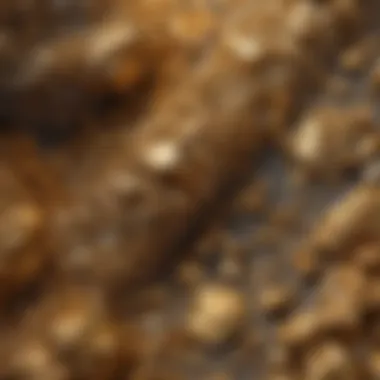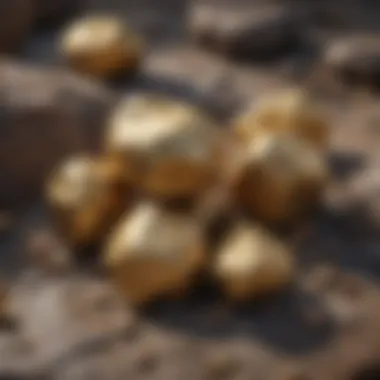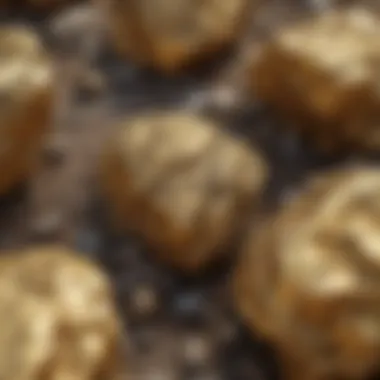Unveiling the Intriguing Characteristics of Gold Ore: A Geological Exploration


Rock and Fossil Identification
Gold ore, despite its distinctiveness from conventional rocks and fossils, contains unique characteristics worth exploring. This precious geological treasure stands out due to its formation process, defining features, and identification methodologies. By delving into the realm of gold ore, enthusiasts can gain profound insights into its composition and appearance.
Geological Insights
Uncovering the mysteries of gold ore involves understanding its geological formations and intricate processes. From the historical significance of this revered material to the notable discoveries in the field of geology, gold ore commands attention and admiration for its rarity and beauty.
Introduction to Gold Ore
In the vast realm of geological treasures, the exploration of gold ore stands out as a pursuit filled with intrigue and fascination. This article embarks on a detailed journey into the realm of gold ore, shedding light on its unique characteristics, formation process, and significant implications within the field of earth sciences. By delving into the essence of gold ore, we aim to provide a comprehensive guide for both seasoned collectors and passionate enthusiasts, unveiling the secrets held by this precious geological marvel.
Definition of Gold Ore
Gold ore, by definition, refers to a deposit in which gold is found naturally occurring within rocks or minerals. It symbolizes the presence of one of the most coveted metals in human history, sparking gold rushes, mining endeavors, and technological advancements across civilizations. The defining feature of gold ore is its composition rich in gold particles, varying in concentrations and distribution patterns based on geological processes and environmental factors.
Formation Process of Gold Ore
The formation of gold ore is a complex interplay of geological events that span millions of years. Typically, gold ore originates from hydrothermal processes, where hot fluids carrying gold and other elements migrate through cracks and fissures in the Earth's crust. As these fluids cool and interact with host rocks, gold precipitates out, forming deposits that can be observed in various geological settings. Understanding the intricate formation process of gold ore is essential in deciphering its distribution patterns and economic significance.
Significance of Gold Ore


Gold ore holds immense significance in several realms, ranging from economic value to scientific exploration. Economically, gold ore fuels a multi-billion dollar industry, driving mining operations and supporting global trade. Its scarcity and unique properties also make it a valuable asset for investors and collectors alike. Moreover, from a scientific standpoint, studying gold ore provides insights into Earth's geological history, mineral formation mechanisms, and environmental processes. The significance of gold ore encompasses cultural, historical, and practical dimensions, making it a topic of enduring interest and relevance in the realm of geological sciences.
Physical Characteristics of Gold Ore
Gold ore's physical characteristics play a crucial role in its identification and assessment. Understanding its physical properties can provide valuable insights into its origin, processing potential, and quality. Key elements to consider include color, luster, texture, structure, density, and weight. The examination of these attributes is fundamental in distinguishing various types of gold ores and determining their mineral composition.
Color and Luster
Color and luster are primary characteristics that aid in gold ore recognition. Gold ore typically exhibits a distinct yellow color, varying from bright golden hues to deeper shades depending on impurities. Luster, describing how light reflects off the surface, can be metallic, giving the ore a shiny appearance. An expert eye can discern subtle color variations and luster differences, providing essential clues about the ore's composition and purity.
Texture and Structure
Gold ore's texture and structure offer valuable insights into its formation process and potential mineral content. The texture may range from fine-grained to coarse, indicating the conditions under which the ore crystallized. Structural features like veining, banding, and brecciation provide clues about the ore's geological history and mineralization processes. Studying these aspects can help geologists decipher how the gold ore formed and predict its behavior during extraction and processing.
Density and Weight
The density and weight of gold ore are critical parameters for assessing its value and processing feasibility. Gold ore exhibits a high density due to its metallic nature, making it heavier than most common rocks and minerals. Measuring the ore's weight in correlation with its volume can help determine its purity and gold content. Understanding the density variations within gold ore deposits is essential for efficient mining and extraction processes, guiding resource estimation and ore processing strategies.
Visual Inspection of Gold Ore
In the context of this comprehensive exploration of gold ore, the visual inspection plays a crucial role in unraveling the true nature of this precious mineral. Visual inspection serves as the initial step in identifying and understanding gold ore, providing essential visual cues that hint at its composition and quality. By closely examining the surface features, veins, inclusions, impurities, and trace elements present in the ore, collectors and enthusiasts can gather valuable insights into its geological history and potential value.


Surface Features
Surface features are key indicators that reveal important details about the history and formation of gold ore. The texture, morphology, and overall appearance of the surface can offer clues about the conditions in which the ore was formed and any subsequent geological processes it has undergone. By studying surface features closely, enthusiasts can distinguish between different types of gold ore and gain a deeper appreciation for the complexities of its mineralogy.
Veins and Inclusions
Veins and inclusions within gold ore are fascinating microcosms that provide a glimpse into the geological events that shaped the ore's formation. These intricate patterns and embedded minerals offer valuable information about the source of the gold, the temperature and pressure conditions during formation, as well as any secondary processes that have altered the ore over time. Understanding veins and inclusions is essential for accurately identifying and evaluating the quality of gold ore specimens.
Impurities and Trace Elements
The presence of impurities and trace elements in gold ore holds significant importance in assessing its purity and potential value. Impurities can range from common minerals to rare elements, each contributing to the ore's overall characteristics and aesthetic appeal. By conducting detailed analyses of these impurities and trace elements, enthusiasts can gain valuable insights into the ore's origin, composition, and even its geographic provenance.
Identification Techniques for Gold Ore
In the pursuit of unraveling the mysteries held within gold ore, the importance of mastering identification techniques cannot be overstated. Identifying the unique characteristics and properties of gold ore is essential for both enthusiasts and experts in the geological field. By delving into precise identification techniques, researchers can discern valuable insights into the composition, purity, and origin of each specimen they encounter. A meticulous approach to identification not only enhances one's understanding of the geological treasure at hand but also opens doors to a myriad of applications in various industries such as mining, jewelry-making, and research.
Chemical Analysis
Chemical analysis stands at the forefront of identification techniques for gold ore, offering a detailed glimpse into the elemental composition of each sample. Through techniques such as spectroscopy and elemental analysis, researchers can pinpoint the exact constituents present in the ore, ranging from gold and silver to trace elements like copper, arsenic, and more. This method provides crucial data for assessing the quality and purity of the gold ore, aiding in determining its potential applications and market value.
Mineralogical Testing


Mineralogical testing serves as a pivotal aspect of gold ore analysis, focusing on the mineral composition and crystal structure of the specimens under scrutiny. By employing methods like X-ray diffraction and microscopic examination, researchers can identify the crystalline phases present in the ore, offering insights into its formation history and geological significance. Mineralogical testing not only aids in distinguishing different types of gold ores but also plays a vital role in understanding the broader geological context in which these precious rocks are found.
Laboratory Examinations
Laboratory examinations represent the culmination of comprehensive identification techniques for gold ore, integrating various analytical approaches to paint a holistic picture of each specimen. From microscopic studies to thermal analyses, researchers dive deep into the physical and chemical properties of gold ore, unraveling its mysteries layer by layer. These examinations provide invaluable data on aspects such as ore texture, impurities, and structural anomalies, shedding light on the intricate nature of gold formation and deposition.
Common Misconceptions about Gold Ore
Exploring the realm of gold ore brings to light numerous misconceptions that often cloud the understanding of this precious mineral. Disentangling truth from fiction is crucial in this domain as misinterpretations can impact decision-making processes profoundly. By elucidating the disparities between authentic gold ore and the deceptive Fool's Gold, collectors and enthusiasts can enrich their knowledge, honing their ability to discern true geological treasures.
Gold Ore vs. Fool's Gold
Distinguishing between genuine gold ore and its misleading counterpart, Fool's Gold, is a task demanding acute observation and a deep understanding of geological formations. While both may exhibit a similar glimmer, Fool's Gold, scientifically known as pyrite, diverges significantly in composition and value. This distinction is pivotal for collectors, ensuring that their prized specimens are indeed the coveted gold ore and not a mere impostor.
Natural Variations in Gold Ore
The variability present in gold ore's appearance and composition underscores the intricate processes that govern its formation. These natural variations, shaped by geological phenomena and environmental factors, yield a spectrum of hues and textures, ranging from glittering to dull. Embracing this diversity enhances collectors' appreciation for the nuances within the world of gold ore, transforming each specimen into a unique piece of Earth's history.
Market Value and Rarity
A defining aspect of gold ore lies in its market value intricately linked to its rarity and purity. As a prized commodity across civilizations, gold ore's worth transcends mere monetary value, embodying historical significance and enduring allure. Understanding the dynamics of market fluctuations and rarity assessments empowers enthusiasts to navigate the intricate landscape of gold ore acquisitions, ensuring informed decisions rooted in both passion and prudence.
Conclusion
Gold ore, a subject contentious yet intriguing, stands out as a focal point in the exploration of earth's geological wonders. In this article, we have delved deep into the unique characteristics and appearance of gold ore, unraveling its mysteries and significance. Understanding the composition and properties of gold ore is crucial for various industries, from mining to jewelry making. By deciphering the distinctive traits of gold ore, individuals can not only identify this precious mineral but also appreciate its value and relevance in our world.
Summary of Key Points
- Gold ore possesses a distinctive appearance characterized by its color, luster, texture, and structure, which help distinguish it from other minerals.
- Visual inspection plays a vital role in identifying gold ore, focusing on surface features, veins, inclusions, impurities, and trace elements present in the sample.
- Identification techniques such as chemical analysis, mineralogical testing, and laboratory examinations are instrumental in confirming the presence of gold ore and determining its quality.
- Common misconceptions about gold ore, including confusion with fool's gold and misconceptions regarding market value and rarity, need to be clarified to avoid misunderstandings.
- The exploration of gold ore is a fascinating journey that unveils not only its physical attributes but also its geological significance and economic value, enriching our knowledge of this precious resource.







